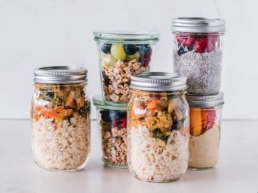By Irazema Garcia, First Mile Care DPP Coach
As a personal fitness chef with a master’s degree in health education and holistic nutrition, planning menus and preparing meals is something I am asked about a lot. For many people, it’s a real challenge. Sometimes it’s the time commitment that’s involved in developing menus; for others it may seem overwhelming to estimate how much food to buy and make, or decide what you’re going to eat on Wednesday when it’s only Sunday.
Learning to plan your meals is an important part of the First Mile Care Diabetes Prevention Program (DPP). By doing most of the prep in advance, you’ll find it easier to be more aware of what you eat, thereby reducing the risk of your prediabetes developing into type 2 diabetes.
Meal prepping was a recent topic in our webinar series on “Diabetes Prevention in Action” where we discussed several major benefits to preparing meals in advance.
Budget-friendly: You’ll save money when doing your food shopping, because you’ll make more conscious purchases. You’ll be focused on buying the items essential for your menus and not make as many spontaneous purchases that end up spoiling in the back of the fridge.
Time-saving: If you do your food preparation “in bulk” ahead of time, the way a restaurant does, you’ll save time preparing every single item for every meal. There are many meal ingredients that you can wash, chop, grill, and roast in advance. For example, soups, sauces, and salad vinaigrettes can be made one time to cover the week. Vegetables can be chopped and roasted. You can bake chicken in advance, or roll ground meat into meatballs or flatten into burger patties so they’re ready to cook. Then when the time comes to prepare a meal, you can just pull the prepared dishes out of the fridge, heat up if needed, and mix ‘n’ match all your prepared options on your plate.
Versatility and seasonality
Look for meal inspirations by reviewing your cache of favorite recipes, see what recipes catch your eye online, and glance through any advertisements for sale items at your grocery store. Choose ingredients for versatility and seasonality.
In-season items are usually more flavorful so will need fewer additional ingredients for a dish, thereby requiring less prep time. When it comes to proteins, it’s also perfectly okay to include some canned items on your menu, such as tuna, salmon, or chicken. Their shelf life will help you save trips to the grocery store.
You want to look at items for their versatility so that you can include them in multiple dishes during the week — for example, a head of cauliflower can be eaten raw in a salad, steamed, mashed, or riced up. (See the blog post with my recipe for delicious roasted cauliflower with lemon tahini sauce.)
Your aim is to ensure that every meal has the ideal balance of 50% produce, 25% starches and fibers, and 25% protein. It’s also essential to include some fats in the form of nuts, olives, avocados, coconut oil, and olive oil. Proteins and fats are what help you feel full, so if you notice you are still hungry after a meal, you may need to bump up your protein and fat intake at each serving.
Take note of your menu
Planning your meals in advance can take some time — expect to spend up to 3-4 hours to plan and prepare a full week’s menu. If meal planning for a week seems overwhelming, break up the week in smaller chunks. Start out prepping two days at a time, and then gradually extend your menu plan. You could also try preparing just one daily meal in advance — for example, plan out your breakfast for the week, while making lunch and dinner as you go.
No matter how many meals you plan, writing down your menu will help you not only overcome challenges, but remember your favorite recipes. It will also help you with maintaining your food journal, the subject of an earlier webinar with Coach Karalyn Cass.
My webinar includes more planning and shopping tips and reviews a sample menu for the week. I hope it helps you determine the type of meal planning that works best for you.
To learn more about how you can benefit from the First Mile Care Diabetes Prevention Program, take our prediabetes risk test and get started today!




